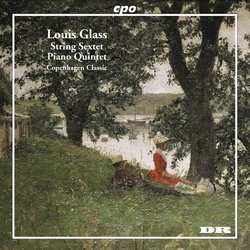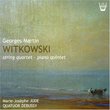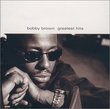| All Artists: Louis Glass, Christina Bjørkøe Title: Louis Glass: String Sextet/Piano Quint Members Wishing: 0 Total Copies: 0 Label: Cpo Records Original Release Date: 1/1/2005 Re-Release Date: 6/21/2005 Genre: Classical Styles: Chamber Music, Historical Periods, Classical (c.1770-1830) Number of Discs: 1 SwapaCD Credits: 1 UPC: 761203706228 |
Search - Louis Glass, Christina Bjørkøe :: Louis Glass: String Sextet/Piano Quint
CD DetailsSimilar CDs
|
CD ReviewsChamber Music by a Danish Contemporary of Carl Nielsen J Scott Morrison | Middlebury VT, USA | 07/04/2005 (4 out of 5 stars) "Louis Glass (1864-1936) was born in Copenhagen a year before his compatriot Carl Nielsen, but his music is much older-sounding that Nielsen's, largely because he was initially a follower of the style of the notably conservative Niels Gade, a composer who was the leader of the previous generation of Danish composers. The son of a piano professor, Glass reached professional levels in both his piano and cello playing and indeed made his solo début playing each of those instruments. He was a leading pedagogue in Denmark at the end of the 19th century and up to his death in the 1930s. He was later influenced by the music of Franck and Bruckner. He is primarily remembered for his symphonies. Here we have his two most important chamber pieces, a string sextet and a piano quintet, played by Danish musicians.
The String Sextet in G Major, Op. 15, is a four-movement work (fast-slow-fast-fast) notable for its square thematic material, often repeated in sequences, and its insistent, if sometimes awkward, rhythmic figures. Although written in the early 1890s, harmonically it sounds as if it could have been written thirty years earlier. There is some influence of Bruckner in the block construction. Aside from a harmonically interesting trio section in the scherzo and the neat formal construction, this is not a terribly memorable work. The string sextet, Copenhagen Classic, plays with ardor that sometimes approaches harshness. In the Piano Quintet in C Major, Op. 22, Copenhagen Classic are joined by pianist Christina Bjoerkoe. The instrumentation is that of the Schumann Piano Quintet. Written 5-6 years after the Sextet, the Piano Quintet was dedicated to the Swedish composer and violinist Tor Aulin whose Aulin String Quartet (with composer Wilhelm Stenhammar at the piano) premièred the work in 1897. Possibly because Glass was himself a fine pianist as well as a string player, the work blends the sounds of strings and piano expertly. But in a number of passages the work almost sounds like a piano concerto with string accompaniment. This allows Glass to vary his means of construction and in the event the Quintet is an altogether more impressive piece than the Sextet. The work opens with a striking ceremonial fanfare-like passage whose rhythm recurs throughout. There are Schumannesque passages that feature the 'Legendton' sound so frequent in Schumann's piano music; one hears the similarity of that sound to the organ-influenced string writing deriving from Bruckner and this makes for a satisfying stylistic synthesis. It may be simply because I preferred the Quintet, but it sounds as if the instrumentalists are more convinced by the quality of the Quintet than the Sextet. Whatever the reason, this is a successful performance of a worthy late Romantic chamber work. TT=71:00 Scott Morrison" |



